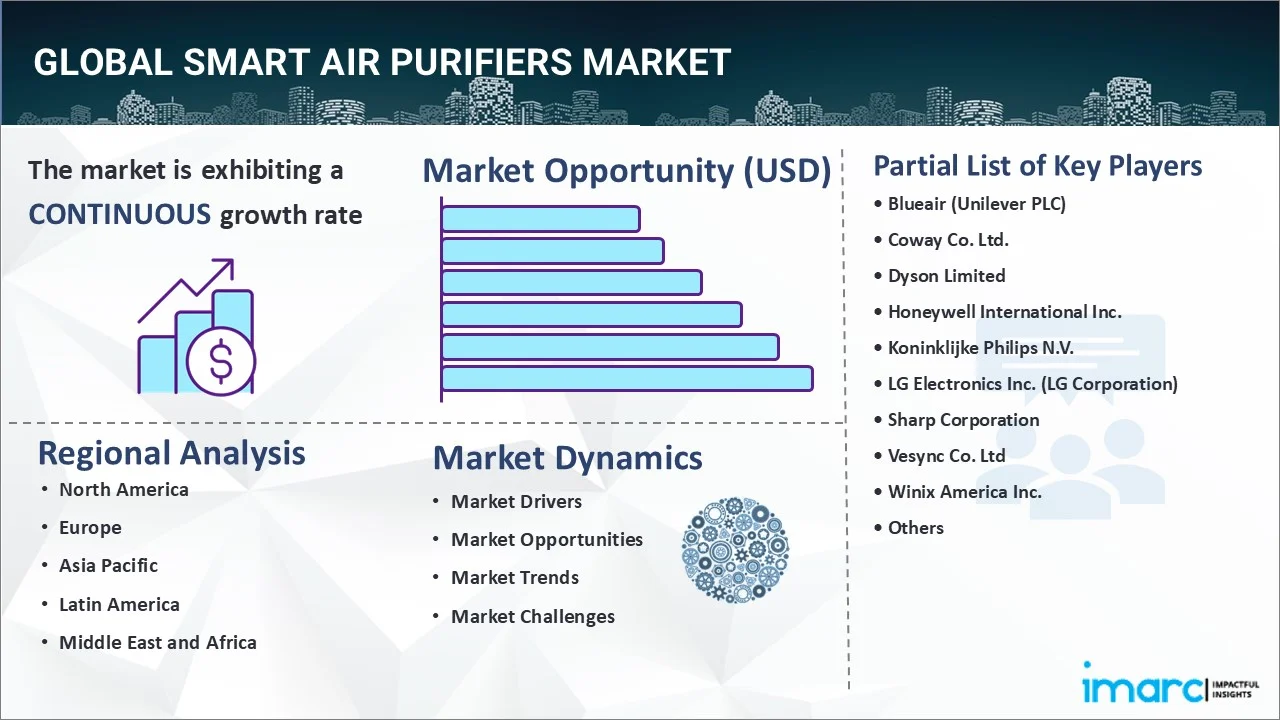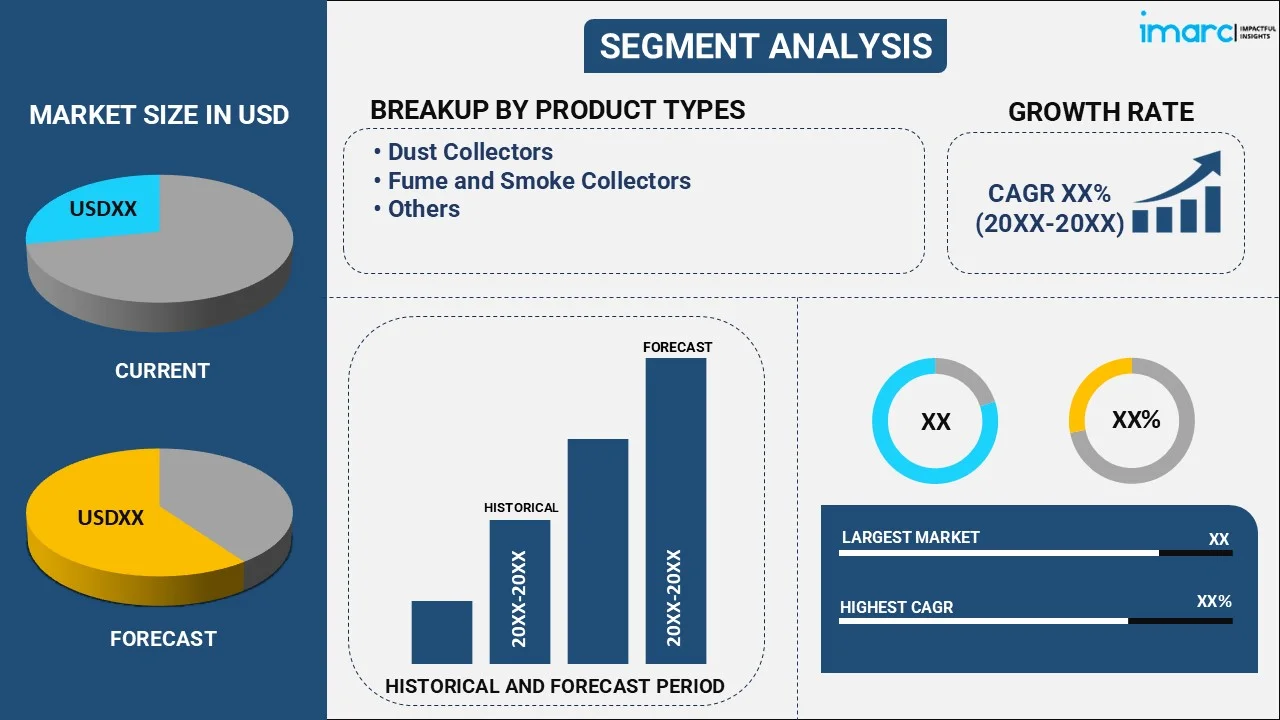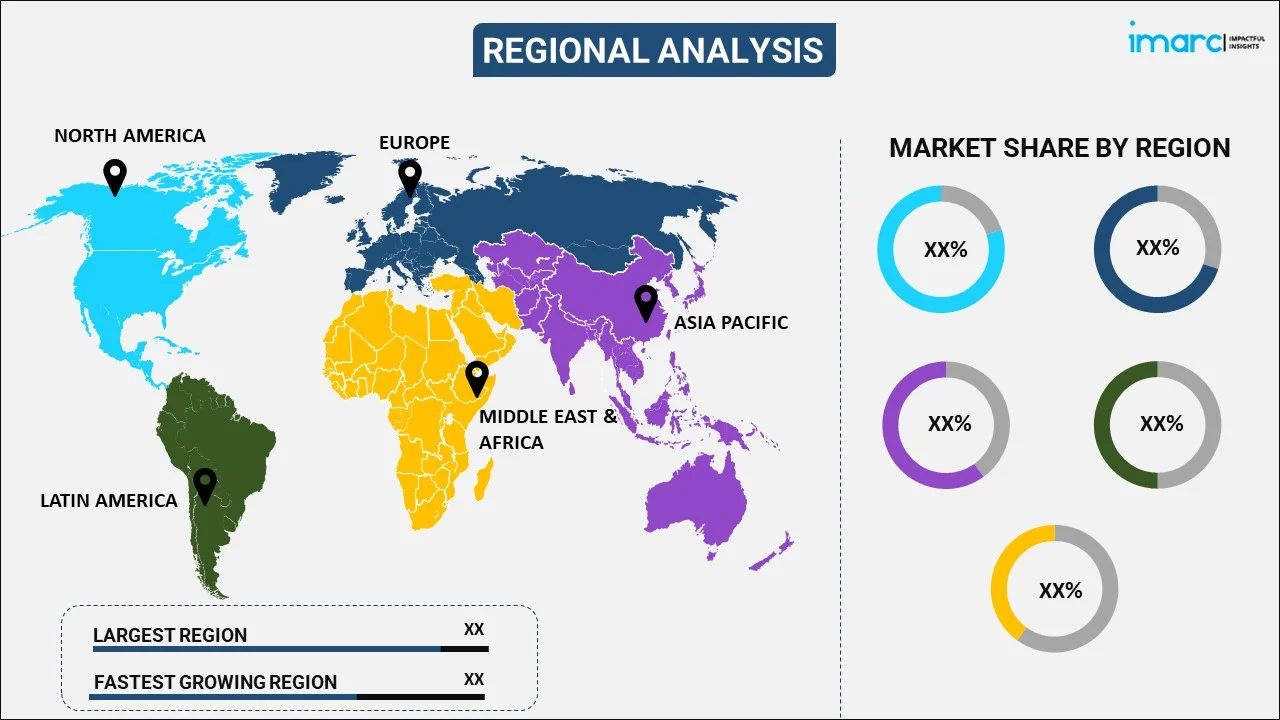
Smart Air Purifiers Market Report by Product Type (Dust Collectors, Fume and Smoke Collectors, and Others), Technique (High-Efficiency Particulate Air (HEPA), Thermodynamic Sterilization System (TSS), Ultraviolet Germicidal Irradiation, Ionizer Purifiers, Activated Carbon Filtration, and Others), Distribution Channel (Online, Offline), End User (Residential, Commercial, and Others), and Region 2025-2033
Global Smart Air Purifiers Market:
The global smart air purifiers market size reached USD 7.3 Billion in 2024. Looking forward, IMARC Group expects the market to reach USD 13.1 Billion by 2033, exhibiting a growth rate (CAGR) of 6.65% during 2025-2033. The growing consumer awareness regarding the adverse effects of pollution on health is primarily driving the market. At present, Asia Pacific holds the largest market share, driven by rapid population growth and increasing awareness about respiratory health.
|
Report Attribute
|
Key Statistics
|
|---|---|
|
Base Year
|
2024
|
|
Forecast Years
|
2025-2033
|
|
Historical Years
|
2019-2024
|
|
Market Size in 2024
|
USD 7.3 Billion |
|
Market Forecast in 2033
|
USD 13.1 Billion |
| Market Growth Rate 2025-2033 | 6.65% |
Smart Air Purifiers Market Analysis:
- Major Market Drivers: The inflating concerns about declining air quality are among the key drivers catalyzing the market. Moreover, the growing number of commercial spaces is also acting as another significant growth-inducing factor.
- Key Market Trends: The widespread IoT integration to enable automatic adjustments for maintaining optimal room air quality is contributing to the market.
- Competitive Landscape: Some of the prominent companies in the global market include Blueair (Unilever PLC), Coway Co. Ltd., Dyson Limited, Honeywell International Inc., Koninklijke Philips N.V., LG Electronics Inc. (LG Corporation), Sharp Corporation, Vesync Co. Ltd, Winix America Inc., and Xiaomi Corporation, among many others.
- Geographical Trends: Asia Pacific exhibits a clear dominance in the market, owing to the development of novel product variants featuring innovative attributes, including ozone generators, ultraviolet (UV) light technology, voice control, and electrostatic precipitators.
- Challenges and Opportunities: One of the limitations hindering the market is the high cost of advanced technology. However, the increasing focus of key players on improving manufacturing efficiency is anticipated to fuel the market over the forecasted period.

Smart Air Purifiers Market Trends:
Growing Technological Advancements
Continuous technological innovations, including the introduction of activated carbon filters, HEPA filters, and UV-C light technology, are propelling the market. They enhance the purification process by targeting a wide range of pollutants, including odors, particulate matter, airborne microbes, etc. For example, in July 2024, SOTO PLUS introduced SOTO-Y6, an intelligent air purifier with next-generation sterilization technology, in Korea. Apart from this, smart air purifiers can automatically adjust their settings based on pollution levels and user preferences, which will continue to fuel the market in the coming years.
Rising Focus on Health
With the increasing concerns about air pollution and its impact on health, particularly in urban areas, individuals across the globe are extensively investing in air purifiers to ensure cleaner indoor air, which is escalating the smart air purifiers market demand. Additionally, they are equipped with advanced sensors that can monitor air quality in real time and provide insights through connected apps, thereby allowing users to take proactive measures to protect their health. For example, in May 2024, Xiaomi launched the MIJIA All-Effect Air Purifier Ultra Enhanced Edition in China to ensure the removal of various air pollutants.
Increasing Need for Energy Efficiency
Modern smart air purifiers are specifically designed to consume less energy without compromising on performance, thereby addressing the elevating concern over energy consumption. Features, such as energy-saving modes and timers, allow users to minimize electricity usage by operating the purifier only when necessary. For example, in June 2024, IQAir unveiled new XE air purifiers in North America. With Wi-Fi smart app integration, they can be remotely controlled and fully integrated with IQAir's AirVisual air quality app. The XEs also include three smart modes, allowing for sensor-based operation.
Global Smart Air Purifiers Industry Segmentation:
IMARC Group provides an analysis of the key trends in each segment of the market, along with the smart air purifiers market forecast at the global, regional, and country levels for 2025-2033. Our report has categorized the market based on the product type, technique, distribution channel, and end user.
Breakup by Product Type:

- Dust Collectors
- Fume and Smoke Collectors
- Others
Dust collectors currently exhibit a clear dominance in the smart air purifiers market share
The report has provided a detailed breakup and analysis of the market based on the product type. This includes dust collectors, fume and smoke collectors, and others. According to the report, dust collectors represented the largest market segmentation.
Dust collectors are essential systems used in various industries to improve air quality by capturing and removing airborne dust and particulate matter. Brands like Donaldson Torit and Camfil Farr provide advanced dust collection systems that not only enhance workplace safety by reducing respiratory risks but also comply with stringent environmental regulations.
Breakup by Technique:
- High-Efficiency Particulate Air (HEPA)
- Thermodynamic Sterilization System (TSS)
- Ultraviolet Germicidal Irradiation
- Ionizer Purifiers
- Activated Carbon Filtration
- Others
Currently, high-efficiency particulate air (HEPA) holds the largest smart air purifiers market revenue
The report has provided a detailed breakup and analysis of the market based on the technique. This includes high-efficiency particulate air (HEPA), thermodynamic sterilization system (TSS), ultraviolet germicidal irradiation, ionizer purifiers, activated carbon filtration, and others. According to the report, high-efficiency particulate air (HEPA) represented the largest market segmentation.
High-efficiency particulate Air (HEPA) filters represent the largest segmentation in the market due to their exceptional ability to capture and remove the smallest and most harmful airborne particles. For instance, smart air purifiers like the Dyson Pure Cool and the Honeywell HPA300 use HEPA filtration to ensure optimal air purification.
Breakup by Distribution Channel:
- Online
- Offline
The report has provided a detailed breakup and analysis of the market based on the distribution channel. This includes online and offline.
Smart air purifiers are distributed through both online and offline channels, each offering unique advantages that cater to different consumer preferences and shopping behaviors. Online distribution channels provide consumers with the convenience of browsing a wide variety of models, comparing prices, and reading customer reviews from the comfort of their homes. On the other hand, offline distribution channels, such as brick-and-mortar stores like Home Depot and specialty electronics retailers, allow them to physically examine and test smart air purifiers before purchasing. This is positively influencing the smart air purifiers market outlook.
Breakup by End User:
- Residential
- Commercial
- Others
Residential accounts for the majority of the total smart air purifiers market statistics
The report has provided a detailed breakup and analysis of the market based on the end user. This includes residential, commercial, and others. According to the report, residential represented the largest market segmentation.
Smart air purifiers for residential use have become increasingly popular as more people recognize the importance of maintaining clean indoor air quality. These devices are equipped with advanced features such as real-time air quality monitoring, app connectivity, and automatic adjustments, making them highly convenient for home use. For example, the Dyson Pure Cool Link and the Blueair Classic 480i offer HEPA filtration, which effectively removes pollutants like dust, pollen, pet dander, and even certain bacteria and viruses, ensuring a healthier living environment.
Breakup by Region:

- North America
- United States
- Canada
- Asia-Pacific
- China
- Japan
- India
- South Korea
- Australia
- Indonesia
- Others
- Europe
- Germany
- France
- United Kingdom
- Italy
- Spain
- Russia
- Others
- Latin America
- Brazil
- Mexico
- Others
- Middle East and Africa
Asia Pacific currently dominates the market
The smart air purifiers market research report has also provided a comprehensive analysis of all the major regional markets, which include North America (the United States and Canada); Asia Pacific (China, Japan, India, South Korea, Australia, Indonesia, and others); Europe (Germany, France, the United Kingdom, Italy, Spain, Russia, and others); Latin America (Brazil, Mexico, and others); and the Middle East and Africa. According to the report, Asia Pacific accounted for the largest market share.
The Asia Pacific smart air purifiers market is experiencing rapid growth driven by the increasing urbanization, the rising pollution levels, and heightened awareness of health and air quality. Countries like China, Japan, and India are at the forefront of this expansion due to their large populations and significant air pollution challenges. In China, brands, such as Xiaomi and TCL have launched smart air purifiers equipped with advanced features like real-time air quality sensors, app control, and HEPA filtration, catering to tech-savvy consumers seeking effective solutions for polluted urban environments.
Competitive Landscape:
The market's competitive landscape is characterized by multiple players including established brands, emerging startups, and specialty manufacturers. Presently, leading companies are investing in research and development to introduce innovative features and technologies in their smart air purifiers. This includes incorporating IoT connectivity, artificial intelligence for better air quality monitoring, and advanced filtration systems. They are also expanding their product portfolios to cater to different consumer needs, which is one of the smart air purifiers market price trends. This involves offering a range of models with varying capacities, designs, and price points to target a broader customer base. Moreover, leading players are collaborating with other companies and technology providers for the integration of smart air purifiers with other smart home devices or platforms, enhancing convenience for consumers.
The market research report has provided a comprehensive analysis of the competitive landscape. Detailed profiles of all major market smart air purifiers companies have also been provided. Some of the key players in the market include:
- Blueair (Unilever PLC)
- Coway Co. Ltd.
- Dyson Limited
- Honeywell International Inc.
- Koninklijke Philips N.V.
- LG Electronics Inc. (LG Corporation)
- Sharp Corporation
- Vesync Co. Ltd
- Winix America Inc.
- Xiaomi Corporation
(Please note that this is only a partial list of the key players, and the complete list is provided in the report.)
Smart Air Purifiers Market Recent Developments:
- July 2024: SOTO PLUS introduced SOTO-Y6, an intelligent air purifier with next-generation sterilization technology, in Korea.
- June 2024: IQAir unveiled new XE smart air purifiers in North America that can be remotely controlled and fully integrated with IQAir's AirVisual air quality app.
- May 2024: Xiaomi launched the MIJIA All-Effect Air Purifier Ultra Enhanced Edition in China to ensure the removal of various air pollutants.
Smart Air Purifiers Market Report Scope:
| Report Features | Details |
|---|---|
| Base Year of the Analysis | 2024 |
| Historical Period | 2019-2024 |
| Forecast Period | 2025-2033 |
| Units | Billion USD |
| Scope of the Report | Exploration of Historical Trends and Market Outlook, Industry Catalysts and Challenges, Segment-Wise Historical and Predictive Market Assessment:
|
| Product Types Covered | Dust Collectors, Fume and Smoke Collectors, Others |
| Techniques Covered | High-Efficiency Particulate Air (HEPA), Thermodynamic Sterilization System (TSS), Ultraviolet Germicidal Irradiation, Ionizer Purifiers, Activated Carbon Filtration, Others |
| Distribution Channels Covered | Online, Offline |
| End Users Covered | Residential, Commercial, Others |
| Regions Covered | Asia Pacific, Europe, North America, Latin America, Middle East and Africa |
| Countries Covered | United States, Canada, Germany, France, United Kingdom, Italy, Spain, Russia, China, Japan, India, South Korea, Australia, Indonesia, Brazil, Mexico |
| Companies Covered | Blueair (Unilever PLC), Coway Co. Ltd., Dyson Limited, Honeywell International Inc., Koninklijke Philips N.V., LG Electronics Inc. (LG Corporation), Sharp Corporation, Vesync Co. Ltd, Winix America Inc., Xiaomi Corporation, etc. |
| Customization Scope | 10% Free Customization |
| Post-Sale Analyst Support | 10-12 Weeks |
| Delivery Format | PDF and Excel through Email (We can also provide the editable version of the report in PPT/Word format on special request) |
Key Benefits for Stakeholders:
- IMARC's industry report offers a comprehensive quantitative analysis of various market segments, historical and current market trends, market forecasts, and dynamics of the smart air purifiers market from 2019-2033.
- The research report provides the latest information on the market drivers, challenges, and opportunities in the global smart air purifiers market.
- The study maps the leading, as well as the fastest-growing, regional markets. It further enables stakeholders to identify the key country-level markets within each region.
- Porter's five forces analysis assists stakeholders in assessing the impact of new entrants, competitive rivalry, supplier power, buyer power, and the threat of substitution. It helps stakeholders to analyze the level of competition within the smart air purifiers industry and its attractiveness.
- The competitive landscape allows stakeholders to understand their competitive environment and provides insight into the current positions of key players in the market.
Key Questions Answered in This Report
The global smart air purifiers market was valued at USD 7.3 Billion in 2024.
We expect the global smart air purifiers market to exhibit a CAGR of 6.65% during 2025-2033.
The rising demand for smart air purifiers, as they assist in minimizing the presence of harmful chemicals, increasing life expectancy, neutralizing unpleasant odors, improving sleep, relieving symptoms of asthma, etc., is primarily driving the global smart air purifiers market growth.
The sudden outbreak of the COVID-19 pandemic had led to the implementation of stringent lockdown regulations across several nations, resulting in the temporary closure of numerous manufacturing units for smart air purifiers.
Based on the product type, the global smart air purifiers market can be segmented into dust collectors, fume and smoke collectors, and others. Currently, dust collectors hold the majority of the total market share.
Based on the technique, the global smart air purifiers market has been divided into High-Efficiency Particulate Air (HEPA), Thermodynamic Sterilization System (TSS), ultraviolet germicidal irradiation, ionizer purifiers, activated carbon filtration, and others. Among these, High-Efficiency Particulate Air (HEPA) currently exhibits a clear dominance in the market.
Based on the end user, the global smart air purifiers market can be categorized into residential, commercial, and others. Currently, the residential sector accounts for the largest market share.
On a regional level, the market has been classified into North America, Asia-Pacific, Europe, Latin America, and Middle East and Africa, where Asia-Pacific currently dominates the global market.
Some of the major players in the global smart air purifiers market include Blueair (Unilever PLC), Coway Co. Ltd., Dyson Limited, Honeywell International Inc., Koninklijke Philips N.V., LG Electronics Inc. (LG Corporation), Sharp Corporation, Vesync Co. Ltd, Winix America Inc., and Xiaomi Corporation.
Need more help?
- Speak to our experienced analysts for insights on the current market scenarios.
- Include additional segments and countries to customize the report as per your requirement.
- Gain an unparalleled competitive advantage in your domain by understanding how to utilize the report and positively impacting your operations and revenue.
- For further assistance, please connect with our analysts.
 Request Customization
Request Customization
 Speak to an Analyst
Speak to an Analyst
 Request Brochure
Request Brochure
 Inquire Before Buying
Inquire Before Buying




.webp)




.webp)












